Hops (Humulus lupulus and Humulus neomexicanus) are in the Cannabaceae family, which includes Cannabis (hemp and marijuana). Hops are mainly used for brewing beer. The perceived bitterness in an Indian Pale Ale is derived from the hops themselves. Hops can also impart other flavors into beers, such as fruity, citrusy, or spicy notes. However, hops can serve other purposes as well. Chefs can cook with the new sprouts that come out in the spring (Figure 1). Herbalists use hops as a sleep aid in teas, and pillows are filled with hops to help people with insomnia. Further, teas made with hops are said to aid in digestion. Because of their antibacterial properties, hops are sometimes recommended for soaking feet to relieve problems associated with athlete’s foot.
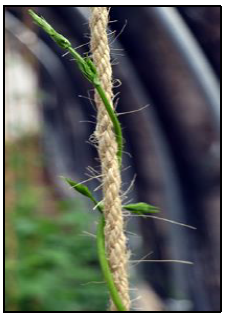
Figure 1. New spring hops shoots or bines.
Historically, hops cultivation and brewing were first mentioned in Picardy, northern France, (cultivation 736 A.D.), and hops were being utilized in beer making by 822 A.D. Three hundred years, later during the 12th and 13th centuries, northern Germany began cultivating hops for the making of beer, followed by England in the 1400s.
The female flower, or cone, primarily serves as the part utilized in beer making. Unpollinated cones produce no seeds when harvested and are preferred (Figure 2). Hops plants are selected to be all female in production and usually cloned (vegetatively propagated) to ensure the female selection. Hops are produced mainly by rhizome division of the plant.

Figure 2. Hops flower or cone.
Hops vines are actually what are referred to botanically as “bines,” because they do not climb with tendrils. The stems wrap around supports with the help of hairs on the stem. Hops produce long bines that can grow up to 25 feet. With the correct nutrition and water, hops grow very rapidly (Figure 3).
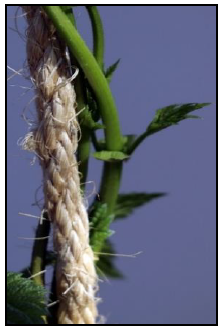
Figure 3. Hops bine growing on natural coconut fiber rope.
Hops are generally grown in temperate, moist climates, so it may come as a surprise to many people that hops can grow in the Mojave Desert. Demand for hops has steadily increased over the last few years due to the growing popularity of draft beers, especially Indian Pale Ales (IPAs). Las Vegas alone has over 30 breweries producing draft beers. These breweries often source their hops from other places, such as Washington State and Germany. Local brewers desire fresh hops to place in their drafts for improved flavor. However, sourcing local hops can be challenging. Certified taste testers also recommend fresh hops over dry packaged hops to create better-flavored brews. Popular varieties that breweries desire are tested and grown at the Research Center and Demonstration Orchard in North Las Vegas. The Research Center is a cooperative effort between University of Nevada Cooperative Extension and the University of Nevada, Las Vegas.
In large hops production areas of the U. S., many producers farm only one-third to three acres per farm unit. The small amount of space needed for hops production bodes well for urban/semi-urban areas of southern Nevada and can provide economic benefits to small enterprise farmers.
Las Vegas Hops
Hops actually use up to 60 percent less water than a traditional alfalfa crop. Research at the Research Center has been testing several hops varieties for adaptability and flavor including: Cascade, Nugget, Mt. Hood, Zeus, Galena, Magnum, Chinook, Centennial, Willamette and neomexicana.
Traditional varieties of hops generally grow best between latitudes 30 degrees - 52 degrees north, (Las Vegas is located at 36 degrees north). Hops require 15 hours of daylight, 120 days frostfree and six to eight weeks of winter temperatures below 40 F. Las Vegas generally meets all of these requirements except for the six to eight weeks of winter temperatures below 40 F. Small batches can be grown outside of these requirements, although yields may be smaller. Most varieties tested at the Research Center have grown well for the past four years with good yields. The Willamette variety, however, yielded an unimpressive amount of hops flowers.
A new variety planted this year, neomexicana, originates from the American Southwest (Figure 4). It grows very well in Arizona and New Mexico, and brewers find it desirable. Sierra Nevada Brewing Company has been testing the potential of neomexicana hops in one of their craft beers. This new-tothe- market native species has potential as a great grower here in southern Nevada, due to its adaptability.
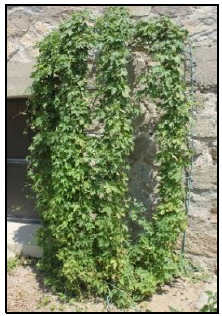
Figure 4. Native neomexicana hops growing in Texas.
Requirements for Hops in Southern Nevada
The hops grown at the Research Center receive:
- 30 minutes of water three times a week using one 5-gallon-per-hour emitter per plant (7.5 gallons/week/plant) in summer.
- 30 minutes of water once a week per plant, using same emitter, in the winter (2.5 gallons/week/plant).
- 30 minutes of water two times a week per plant, using same emitter, in the fall and spring (5 gallons/week/plant).
Each spring, the plants get approximately 1 gallon of compost to help increase the microbial life in the soil and provide some nutrition. Hops also require a large amount of nitrogen, and it is best to apply a high-nitrogen fertilizer, such as ammonium sulfate, two times a year. A soils fertility test should be performed every year to identify necessary nutrient additions required to produce a healthy set of hops bines/flowers. Once a soil test reveals what nutrients are needed, fertilizer can be added at the recommended rates as determined by the test. Hops require approximately 75 pounds of nitrogen per acre for the first growing year and 100-150 pounds in subsequent years. Generally, 1,000 plants can be grown on a single acre. Small-scale growers should apply: 0.15 pounds of Nitrogen (per plant) after the first year of establishment and in succeeding years.
*0.15 lbs. of nitrogen would be:
- 0.5 lbs. of ammonium sulfate (21% N)
- .25 lbs. of urea (46% N)
After the first year, hops bines will also need: 20-30 pounds of phosphorus per acre and 80-150 pounds of potassium per acre (based on soil tests). At the Research Center in North Las Vegas, fertilizer is applied two or three times per year, in mid- February, late March to early April, and late May to early June. Compost is added in early spring, (mid-February) for: moisture retentive mulching, weed control and organic matter supplementation. A granular slow-release fertilizer will persist in the soil longer than a liquid and is therefore recommended. The hops at the Research Center receive 0.5 pounds of ammonium sulfate every year.
Hops climb and produce best on natural fiber ropes. They can grip this type of rope best due to their bines. Once the plants reach 3 feet in length, train three of the best (strongest) bines (or hop stems) clockwise around the rope. The rest of the growth needs removal for the remainder of the growing season, except the three main bines (Figure 5). In the early spring, the extra bines can be harvested for a salad or cooking. Mulch around the hops plants with organic mulch to help reduce weeds, conserve moisture, and add nutrients to the soil. Keep mulch away from the stems to prevent disease, insects and the potential for rotting of the stems.

Figure 5. The strongest three bines are chosen to grow.
Problems
Spider mites can cause major problems on hops. Mites suck out the plant juices and make the plant appear grey. Spider mites also create a web-like substance on the leaves and flowers. Large infestations can lead to leaf abscission and loss of crop viability and flavor.
Aphids generate concern for growing hops. Aphids also suck the sap out of plants and leave a sticky residue on the surface of the leaf called honeydew. These can cause weakened plants due to nutrient loss and sooty molds reduction of photosynthesis.
A high-pressure spray of water usually knocks the spider mites and aphids off the plants. The plants generally do not require pesticides, especially if healthy and well cared for, having received proper amounts of water and fertilizer. Soapy water works to remove aphids and spider mites, although it needs reapplication every three days for at least two weeks, until insects are at a minimum. Caution should be exercised when using soaps or chemicals, as resistance and/or phytotoxicity can occur. Sucking insects such as spider mites and aphids can spread disease as well.
Shade Versus Sun
At the Research Center in North Las Vegas, hops have been grown under dual conditions, shade and full sun. The shaded hops are grown in hoop houses with 30 percent shade (Figure 6).
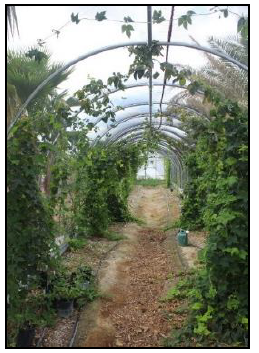
In the sun, the hops are grown on 20-foot single-line trellises (Figure 7). It was found that hops grown in the shaded hoop house sprouted sooner in the spring and had a head start in growing and producing flowers or cones, providing a larger harvest due to the modified environment under the shade cloth.

Harvest
When the flowers are ready for harvest, they easily come off the bine and smell aromatic (not like green grass). A green-grass smell indicates the crop is still immature and needs more time to reach ripeness. Small-scale farmers harvest the hop flowers by cutting the growing ropes with the plants and picking through the bines on the ground (Figure 8). Large-scale producers use mechanized harvesters.
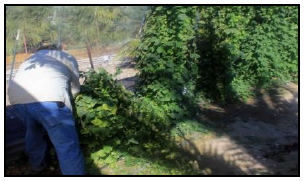
Hops provide abundant economic opportunity for brewing homemade beer or for sale to microbreweries. This bine may also simply be cultivated in the landscape for beauty, a conversation piece, or herbal uses. Enjoy locally grown harvests in southern Nevada.
Hops References
Duke, J. Humulus lupulus. Retrieved 3/2, 2017, from Humulus lupulus L..
Euck, L., & Gehring, D. (2015). In Praded J. (Ed.), The hop grower's handbook. the essential guide for sustainable, small scale production for home and market. White River Junction, VT: Chelsea Green Publishing.
Hieronymus, S. (2012). In Switzer K. (Ed.), For the love of hops. the practical guide to aroma, bitterness and the culture of hops. Boulder, Colorado: Switzer, Kristi.
History of hops. Retrieved 3/21, 2017, from HISTORY OF HOPS.
Kopp, P. (2011). "Hop Fever" in the Willamette Valley. The local and global roots of a regional specialty crop. Oregon Historical Quarterly, 112(4), 406-433.
Wynne, T., O’Callaghan, A., Robinson, M. L. and Anderson, J.
2017,
Growing Hops in Southern Nevada,
Extension | University of Nevada, Reno, FS-17-05


